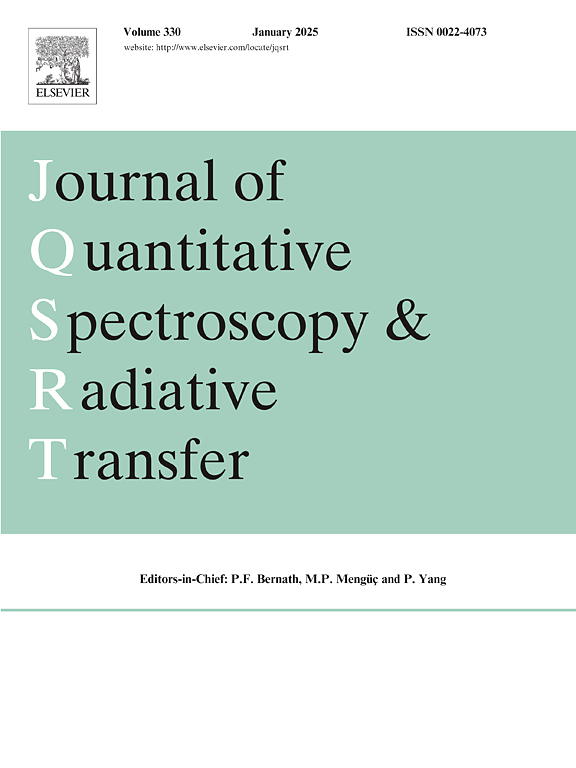氧在233.95 GHz处受塞曼影响的旋转跃迁的微波辐射测量与模拟
IF 1.9
3区 物理与天体物理
Q2 OPTICS
Journal of Quantitative Spectroscopy & Radiative Transfer
Pub Date : 2025-07-15
DOI:10.1016/j.jqsrt.2025.109579
引用次数: 0
摘要
在这项研究中,我们提出了在233.95 GHz的大气氧(16O18O)的塞曼影响旋转转变的测量。这些观测是利用位于瑞典基律纳的瑞典空间物理研究所的基律纳微波辐射计(KIMRA)进行的。这里展示的数据是我们在2024年1月4日地球磁层平静期连续观测的一个例子,在四个不同的视线中。所有测量均以固定天顶角77.6°进行,方位角从0°到270°,以90°为步长。测量结果成功地解决了每个过渡子线,并与PyARTS进行的模拟结果进行了比较,结果表明观测结果与模拟结果在所有方向上都非常吻合。较低频率的氧发射谱线已被用来检索平流层的温度分布。然而,我们发现,在233.95 GHz这个特定频率下的特征不适合大气温度剖面,不像在较低频率下的特征,如118 GHz或50-60 GHz氧带。本文章由计算机程序翻译,如有差异,请以英文原文为准。
Microwave radiometric measurements and simulations of the Zeeman-affected rotational transition of oxygen at 233.95 GHz
In this study, we present measurements of the Zeeman affected rotational transition of atmospheric oxygen () at 233.95 GHz. These observations were conducted using the KIruna Microwave RAdiometer (KIMRA) at the Swedish Institute of Space Physics (IRF) in Kiruna, Sweden. The data presented here are an example set of our continuous observations collected during a calm period of Earth’s magnetosphere on January 4, 2024, in four different lines of sight. All measurements were taken at a fixed zenith angle of , while the azimuth angle varied from 0° to 270° in steps of 90°. The measurements successfully resolved each sub-line of the transition, and comparisons with simulations performed using PyARTS showed excellent agreement between the observations and simulations in all directions. Oxygen emission lines at lower frequencies have been used to retrieve temperature profiles in the stratosphere. We found, however, that the signatures at this particular frequency at 233.95 GHz are not suited for atmospheric temperature profiling unlike those at lower frequencies, such as 118 GHz or signatures in the 50–60 GHz Oxygen band.
求助全文
通过发布文献求助,成功后即可免费获取论文全文。
去求助
来源期刊
CiteScore
5.30
自引率
21.70%
发文量
273
审稿时长
58 days
期刊介绍:
Papers with the following subject areas are suitable for publication in the Journal of Quantitative Spectroscopy and Radiative Transfer:
- Theoretical and experimental aspects of the spectra of atoms, molecules, ions, and plasmas.
- Spectral lineshape studies including models and computational algorithms.
- Atmospheric spectroscopy.
- Theoretical and experimental aspects of light scattering.
- Application of light scattering in particle characterization and remote sensing.
- Application of light scattering in biological sciences and medicine.
- Radiative transfer in absorbing, emitting, and scattering media.
- Radiative transfer in stochastic media.

 求助内容:
求助内容: 应助结果提醒方式:
应助结果提醒方式:


